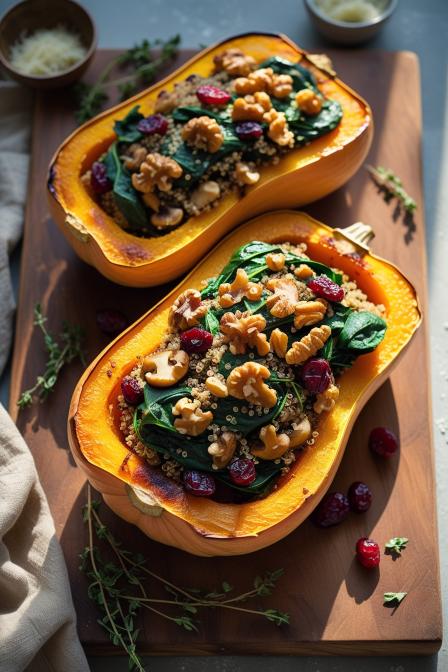I still remember the first time I roasted a butternut squash so big it barely fit in my oven. It was winter, the kind of day where the cold gets under your nails, and the house smelled like cinnamon and wood smoke. That squash turned into dinner, lunch, and—if I’m being honest—a midnight snack straight from the fridge. This is the magic of stuffed butternut squash: it’s a whole meal tucked neatly inside nature’s own serving bowl.
There’s something unapologetically comforting about it. The soft, sweet flesh. The caramelized edges that taste like brown sugar without any sugar at all. And then, whatever you decide to stuff it with—creamy grains, spiced meat, smoky legumes—suddenly the humble squash becomes a show-off centerpiece. This dish isn’t just dinner. It’s art you can eat.
What’s special here is that stuffed butternut squash bends to your will. Breakfast? Sure, fill it with eggs, spinach, and cheese. Lunch? Try quinoa, herbs, and chickpeas. Dinner? Roast it with sausage, wild rice, and mushrooms. It’s the kind of recipe professional chefs love because it’s endlessly adaptable but always looks impressive coming out of the oven.
Ingredients & Substitutions
Here’s the thing—every ingredient you choose for a stuffed butternut squash matters. The sweetness of the squash is your base note, like the cello in an orchestra. Everything else is layered on top to build flavor and texture.
Ingredient Table
| Ingredient | Measurement | Notes & Substitutions |
|---|---|---|
| Butternut squash | 1 large (about 2–3 lbs) | Choose firm, heavy squash with a matte skin |
| Olive oil | 3 tbsp | Can use avocado oil for higher smoke point |
| Salt | 1 tsp | Sea salt for best flavor |
| Black pepper | ½ tsp | Freshly ground for more aroma |
| Garlic | 3 cloves, minced | Roasted garlic adds a sweeter depth |
| Cooked quinoa | 2 cups | Brown rice, couscous, or farro as alternatives |
| Baby spinach | 3 cups | Kale or Swiss chard also work |
| Mushrooms | 1 cup, chopped | Cremini for earthiness, or porcini for luxury |
| Parmesan cheese | ½ cup, grated | Vegan option: nutritional yeast or vegan cheese |
| Dried cranberries | ½ cup | Chopped dates or figs for a different sweetness |
| Walnuts | ½ cup, chopped | Pecans or pumpkin seeds as swaps |
| Fresh thyme | 1 tsp | Dried thyme is okay, but use half the amount |
If you’re sourcing for a restaurant, look for squash with an even shape for consistent cooking times. Fresh herbs always beat dried for brightness—though dried ones hold their ground in long roasting times. And please, don’t grab pre-grated Parmesan unless you like your cheese tasting faintly of cardboard.
Step-by-Step Instructions
The process is simple enough for a home cook, but with a few chef’s tricks, you’ll turn it into a restaurant-worthy plate.
Step 1: Prep the Squash
Slice the squash in half lengthwise. Use a sturdy chef’s knife—this is not the time for your dainty paring knife. Scoop out seeds with a spoon (save them for roasting if you’re not feeling lazy). Brush the cut sides with olive oil, sprinkle with salt and pepper.
Chef’s Tip: Score the flesh lightly in a crosshatch pattern. This lets heat and seasoning get deeper inside and cuts down roasting time by 5–10 minutes.
Step 2: Roast the Squash
Place halves cut side down on a parchment-lined baking sheet. Roast at 400°F (200°C) for 35–45 minutes, depending on size, until the flesh is tender and caramelized at the edges.
Mistake to Avoid: Don’t roast at too low a temperature. You’ll steam the squash instead of caramelizing it.
Step 3: Make the Filling
While the squash roasts, heat olive oil in a skillet over medium heat. Add garlic, cook until fragrant (about 30 seconds), then toss in mushrooms. Cook until they release liquid and it evaporates—wet mushrooms are sad mushrooms. Stir in spinach until just wilted.
Add cooked quinoa, cranberries, walnuts, and thyme. Season generously. Stir in Parmesan until the mix is just melty.
Variation: For a heartier version, brown some Italian sausage first and fold it in with the filling.
Step 4: Stuff & Bake Again
When the squash is tender, flip it cut side up. Scoop out a little flesh from the center to make room for filling (mash this extra and mix into your filling—never waste). Pile the filling high. Return to oven for 10–12 minutes to meld flavors.
Step 5: Serve Hot
Serve straight from the baking tray if it’s casual, or transfer carefully to warm plates for a formal table. Garnish with extra herbs, a drizzle of olive oil, or a sprinkle of flaky salt.
Cooking Techniques & Science
The magic here is all about dry heat and balance. Roasting converts the natural starches in squash into sugars through caramelization and the Maillard reaction. That’s why you get those nutty, almost maple-like notes without adding sweeteners.
Stuffing it after the first roast ensures two things: the squash cooks evenly without the filling drying out, and the flavors marry without losing texture. Professionals often partially scoop the flesh to mix with the filling—this doubles the flavor inside.
Tools That Matter:
- A heavy chef’s knife for safe cutting.
- A half-sheet pan for even roasting.
- A sturdy metal spatula to flip without tearing the flesh.
How to Store & Reheat
Refrigerate leftovers in an airtight container for up to 4 days. To reheat, bake at 350°F (175°C) for about 15 minutes—microwaving works but softens the texture. For freezing, wrap tightly in foil and store up to 2 months; thaw overnight in the fridge before reheating.
Variations & Substitutions
- Vegan: Swap cheese for nutritional yeast and use oil instead of butter.
- Gluten-Free: Already naturally gluten-free—just check your stuffing ingredients.
- Spicy: Add chili flakes or chopped jalapeños to the filling.
- Breakfast: Fill with scrambled eggs, sautéed peppers, and cheddar.
Serving & Pairing Suggestions
This dish loves the spotlight. Serve it as a vegetarian main with crusty bread and a crisp green salad. For richer menus, pair with roasted chicken or lamb.
Drinks? A buttery Chardonnay highlights the squash’s sweetness, while a peppery Syrah balances richer fillings. Herbal teas like chamomile or mint work for a lighter option.
Plating tip: Serve on warm, shallow bowls so the squash sits snug, preventing it from wobbling. A final drizzle of herbed olive oil adds a restaurant flourish.
Best Time to Serve
Stuffed butternut squash is peak autumn fare, but honestly, I’ve served it in July with a glass of chilled white wine and no one complained. It’s especially perfect for holidays—Thanksgiving, Christmas, or even Easter brunch.
For meal prep, roast several squash halves at once and keep fillings ready. This way, you can assemble and bake on demand for quick weeknight dinners.
Conclusion
Stuffed butternut squash is proof that vegetables can be the main event. It’s adaptable, elegant, and deeply satisfying without trying too hard. Professionals love it because it’s a canvas for flavor, and home cooks love it because it’s simple at heart.
If you remember only a few things—roast hot for caramelization, season every layer, and don’t be afraid to overfill—you’ll never make a boring stuffed squash. And maybe, like me, you’ll find yourself sneaking a cold wedge from the fridge at midnight.
FAQs
1. Can I make stuffed butternut squash ahead of time?
Yes, roast the squash and prepare the filling separately up to 2 days ahead. Stuff and bake just before serving for best texture.
2. How do I prevent the filling from drying out?
Add a little broth or olive oil to the filling before the final bake to keep it moist.
3. Is it possible to cook it faster?
Yes, microwaving the halved squash for 5–7 minutes before roasting can cut total cook time by 15 minutes.
4. What’s the best way to cut a butternut squash safely?
Trim the ends, stand it upright, and cut down the middle with a heavy knife. Always keep your fingers tucked away.
5. Can I use acorn squash instead?
Absolutely. Just adjust roasting time, as smaller squashes cook faster.
If you like, I can also create three professional-level gourmet filling variations for this stuffed butternut squash—one vegan, one meat-based, and one breakfast-themed—to make this article even more complete. Would you like me to add them?

